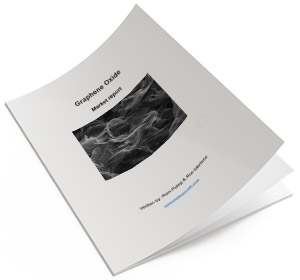Graphene Oxide: Introduction and Market News - Page 24
Graphene-Info launches a new Graphene Oxide market report
We're happy to announce a new market report, Graphene Oxide Market Report. This report, brought to you by the world's leading graphene experts, is a comprehensive guide to the graphene oxide market. Graphene Oxide is an exciting material with promising applications in diverse areas - including energy storage, composite materials, bio-medical, water treatment and more. Graphene Oxide can also be reduced to make conductive graphene flakes (r-GO).
Reading this report, you'll learn all about:
- The difference between graphene oxide and graphene
- Graphene oxide properties
- Possible applications for graphene oxide
- Reduction of graphene oxide to r-GO
- Available materials on the market
The report also provides:
- A list of prominent GO research activities
- A list of all graphene oxide developers and their products
- Sample graphene oxide implementations
- Datasheets for over 20 different GO materials
- Free updates for a year
Exeter team unveils novel graphene production method that could accelerate commercial graphene use
Researchers from the University of Exeter have developed a new method for creating entire device arrays directly on the copper substrates used for commercial manufacture of graphene. Complete and fully-functional devices can then be transferred to a substrate of choice, such as silicon, plastics or even textiles.

This new approach is said to be cheaper, simpler and less time consuming than conventional ways of producing graphene-based devices, thus holding real potential to open up the use of cheap-to-produce graphene devices for a host of applications from gas and biomedical sensors to displays.
Graphene oxide helps in creating antibacterial 'cloak'
Researchers at the Catholic University of the Sacred Heart (UCSC) and the National Research Council (ISC-CNR) in Italy have used graphene oxide to develop an antimicrobial ‘cloak’ which could play a key role in protecting from the build-up of dangerous microbial biofilms.
The team found that an agar hydrogel that contains graphene-oxide and laser printed to mimic the shell surface of the Cancer pagurus crab, acts to lower growth of gram-positive and gram-negative bacteria, and fungal cells. The Cancer pagurus crab evolved an interesting defense against microbial infection - a shell where the outer surface, or the carapace, is shaped in a way which makes it much harder for microbes to grow.
GRAMOFON project aims to capture CO2 with the help of graphene aerogels
Project GRAMOFON, a 3.5 year project that started in October 2016, aims to establish a process for efficient CO2 capture by innovative adsorbents based on modified graphene aerogels and MOF materials. The EU will contribute nearly â¬4.2 million to the project.
The key objectives of GRAMOFON projects are:
- to develop and prototype a new energy and cost-competitive dry separation process for post-combustion CO2 capture based on innovative hybrid porous solids Metal organic frameworks (MOFs) and Graphene Oxide nanostructures.
- to optimize the CO2 desorption process by means of Microwave Swing Desorption (MSD) and Joule effect, that will surpass the efficiency of the conventional heating procedures.
Nanjing team develops graphene oxide-based solar desalination system
Researchers from the Chinese Nanjing University have reportedly developed a graphene oxide-based solar desalination system that does not require a solar concentrator or thermal insulation. Featuring a confined 2D water channel, the system is able to achieve high levels of solar absorption and effective desalination.
The research team stated that it used a graphene oxide film as the basis for a device. The graphene oxide film is said to be foldable and produced using a scalable process. With this at the core of the system, the researchers believe that the development represents "a concrete step for solar desalination to emerge as a complementary portable and personalized clean water solution".
Biolin Scientific commercializes a graphene oxide sensor developed by ICN2
A graphene oxide (GO) sensor co-developed by the ICN2 Nanobioelectronics and Biosensors group has recently been added to the list products offered by Biolin Scientific, a prestigious instrumentation company devoted to the production of analytical devices. The Q-Sense GO sensor enables interaction studies of GO with various analytes (measured substances) of interest and may open the door to various applications with interest for diagnostics, safety/security and environmental monitoring.

Biolin Scientific, a leading Nordic instrumentation company, develops products based on nanotechnology and advanced measurement techniques. The company has a line of instrumentation called Q-Sense, which deals with instruments that enable real-time analysis of surface-molecule interactions with nanogram precision for a wide variety of samples and measurement conditions. Biolin Scientific wanted to incorporate a graphene coated sensor in its Q-Sense sensors list. The collaboration between ICN2 and the Nordic company became plausible because the Institute already had expertise transferring graphene to the surface of interest.
ORA develops GO-enhanced membrane for loudspeakers
ORA, a Canada-based early-stage start-up that develops graphene-enhanced audio equipment, has unveiled its graphene oxide-based composite material, dubbed grapheneQ. The material was thus named because of its low density and high stiffness, that reportedly allow for louder drivers that have a lower Q resonance, and has been specially designed for use in acoustic transducers.

Loudspeakers work by vibrating a thin diaphragm. These vibrations then create pressure waves in surrounding air that produce different sounds depending on their frequency. The membrane in any speaker can be thought of as a simple harmonic oscillator with an intrinsic mass and restoring force. The heavier the membrane’s mass, the more inertia and sharper resonance it has because of its high Q. The most common way to reduce resonance and broaden bandwidth is to add damping, but this ultimately reduces the efficiency of the driver.
The Sixth Element unveils graphene-enhanced tyres
The Sixth Element, a leading producer of graphene products based in China, supported its partner Shangdong Hengyu Technology Group, a leading Chinese tyre manufacturer, in developing tyre formulations proving the positive impact of graphene oxide on the performance of tyres as an example for rubber products.

Adding only a very small amount of The Sixth Elements’ SE2430 to the formulations of the tyre tread, the rate of tyre wear decreased by more than 25%, while tear strength was more than doubled. The Sixth Element Materials Technology presented the new developed heavy duty tyre Horizon HD type during the GRAPHCHINA 2016 conference.
Graphene oxide-based biofoam uses sunlight to clean water
A team of scientists at Washington University has developed a technique for using sheets of graphene oxide to obtain drinkable water using sunlight; The technique involves heating dirty water to a boil - creating purified steam that can be collected and safely consumed.

The team has devised a method of heat localization using bilayered biofoam composed of bacterial nanocellulose (BNC) and reduced graphene oxide (RGO). The bilayer structure was created by growing Gluconacetobacter hansenii bacteria in the presence of graphene oxide flakes.
Graphene, GO and rGO grown onto silicon chips could pave way to biosensors and electronics
Researchers at North Carolina State University have developed a technique that enables the integration of graphene, graphene oxide (GO) and reduced graphene oxide (rGO) onto silicon substrates at room temperature by using nanosecond pulsed laser annealing. The advance may open the door to the possibility of creating new electronic devices, such as smart biomedical sensors.
![]()
In this new technique, the researchers start with a silicon substrate. They top that with a layer of single-crystal titanium nitride, using domain matching epitaxy to ensure the crystalline structure of the titanium nitride is aligned with the structure of the silicon. They then place a layer of copper-carbon alloy on top of the titanium nitride, again using domain matching epitaxy. Finally, the researchers melt the surface of the alloy with nanosecond laser pulses, which pulls carbon to the surface.
Pagination
- Previous page
- Page 24
- Next page
